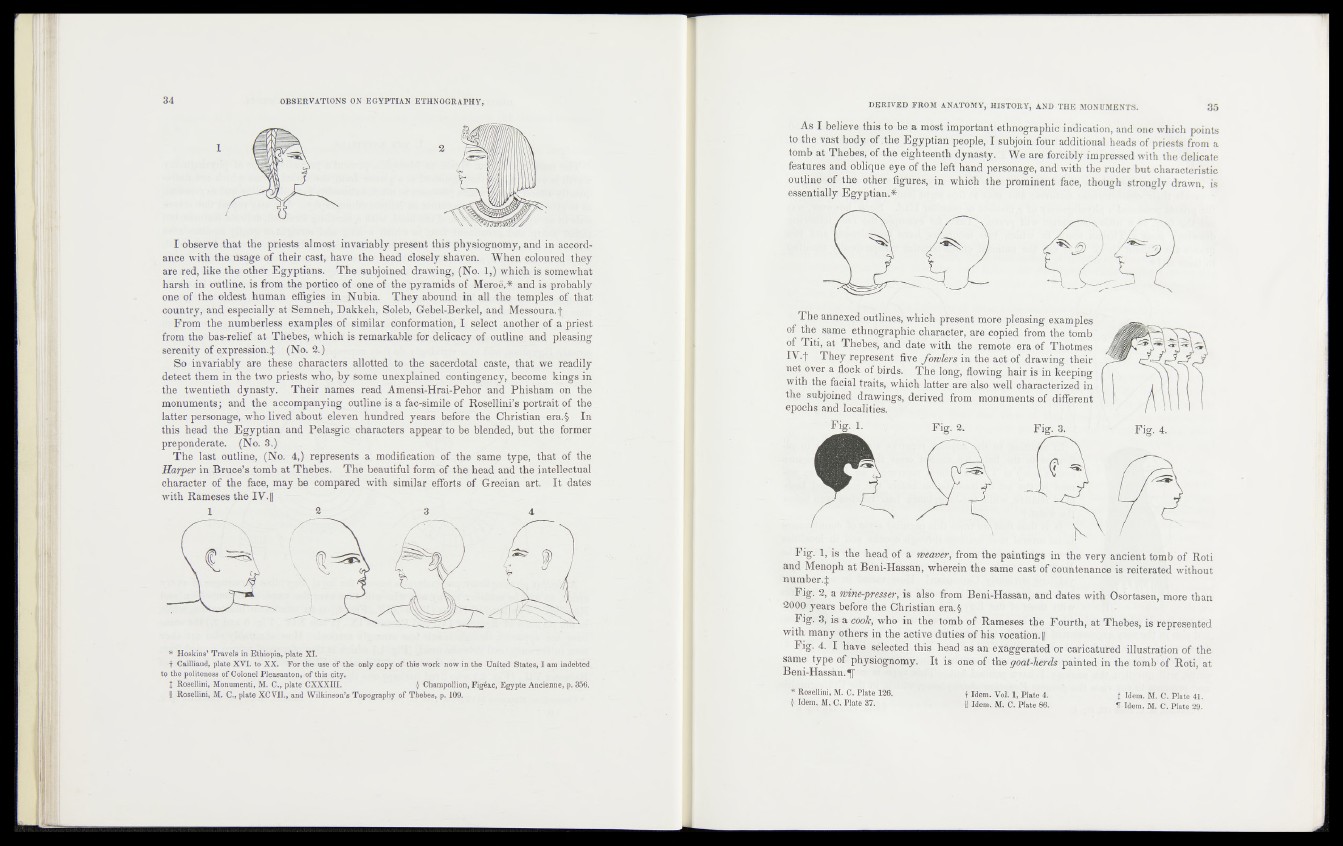
I observe that the priests almost-invariably present this physiogneinvy, and in ,aGgj3j||}|
ance with the usage; cfutbeir aasbihave thé h ^ d -filosely sh^y^%« .When cA w B they
axe «red, hfce the other Egyptians. '.iThe-subjoined, drawing, ( .
harsh in outline; is from the portico of one of the pyramids of MeTQc..Varidi-is^)mba,hl»y
one of the ©Mest,,humaa effigies■ W N ubia. They abound in' all- thre,-templqs(,pf that
country, and especially' at Semneh, Dakkeh,' Soleb, Gehel-Berkel, and Messoura.dn <>.
From the numberless examples; ©fnEiniite conformation, I select fiasptXer,o5^®|1^
from the bas-relief at Thebes, which is remarkable for delicacy pleasing
serenity of expression.:): fe (tNgv %^pi>
So invariably are these characters allotted' to thesacerdotal ca^fe, ,ffiat reaJiiv
detect them in the two priests who,-by some unexplained contingency,' becoim- kiii'j'5rt
the twentieth dynasty. Their names read Amensi-Hrai-PehofWnd Phisham o ir|n e
monuments; and the aecorripanying outline is a fac-simile of Rosellini’s portrait of the
latter-personage,, who livrfabor^é leven hundred yehrs beffinTthe Ghristiangve^tó - In
this head the Egyptian and Pelag ic characters appear to be blended, but-the^former
preponderate. (No. 3 ,|
The last outline,,®©. 4,) represents a medification~bf~thesame type, that of t ^
Harper in Bruce’s tomb at Thebes. The beautiful form'd! the head and thbp^Mlecfual
character of the face, may be compared with similar efforts of- (Grecian art?.- It. dates
with Rameses thé IV. U
m o m 1 ■ s Ë 1 - 3 • H
‘ '* Hoskins’ Travels in Ethiopia, plate XI.
■ f Cailliaud, plate XVI. to XX. For the use of the only copy o f this work now in the United States, I am indebted
to the politeness of Colonel Pleasanton,,of this,city, , :
J Rosellini, Monumenti, M. C.;, p&te CXXXIU. " ' | Champollion, Figéac, Egypte Ancienne, p. 856.
U Rosellini, M. C., plate XCVU., and Wilkinson’s Topography of Thebes, p, 109.
OPAy< I-belih&egtiusdpibela mCsbiimportantiethnograpMc in’dication, and one which points
IP'jthé^ji^^l^Eff^the 1 Igyptianapêoplë*.>IjshÊjo^{&hriadditional]heads of priests from a
eighteenthfldy-nastyi We; are forciblylimpressed with the delicate
pvc of the | | | | hapd’ personage, and with the ruder but characteristic
out^itfe^whei whrlXhtherprominénfc i face, thobglar strongly drawn, is
e s s e nm lilf tjjE g r t’p tia riiX l v i
** lr J.„ ll11!* " , '*■ h ue s* w h lm ^ y ^ e s en t^m ô ^ fjlp le a s ir ig , e x a m p l e s
o |p [ |! $ saiiït* ^ ^ l e g ïa j i^ i c sÆ a r - a ç t e r , a r e fr om p th e itbm b ;
°H0ik^ a-h uiiUi'c?' >Jt™ ili ^niiVVli. ( LI iW l ip iUh,».
Sf f l ^SI1. ^ td'eBi:e^cii|t''ffive»FrniTois m the actolj drawing- tlïcir.
net oter a mg hair jneg
w ithçhe faciattiraiçi, w hicfidptle^arc^also w ell
- (^r-a lv | n g« .-d d rp y c .m n n nm e n t.^ nO di flTnrp.n t.
o p j t d i S j p n d U o è â h u ^ i 'i ^
L>'is thC’-hSad^df a weaver, from the paintirlgs ins^he ver^h&hifnt,tomb of Roti
^nd •’Meno^h’-at BenhHassanpwherem the same1 e a ^ 6 f |® [£ te n a n j||| reiterated without
tom n g b e r tX 1 -
irh’dg.g/ ^rbMe-prmirf-& MsX ffcorn Beni-Hassan, and dates w it^ s o r ta vs0,Wiore than
2a001^ears before the. ®h|i|illa. Srh.^
Fig.'-Sjlis a boo^'whbMn 'thhKtoteblof RameSes the Fdukh,' at Thebes^ ^represented
with many^others in :the active' vb<JatibHJ|p V
Fig. 4.VI have^ l e eted th li^ |||p fW an exagghrated^or ’catoi'catii.red illustTajtid» d f the
same type Oft] physiognomy. It islip^elCf^h'e^oaff-fefds'pSifhteXin the tomb'of Roti, at
■:Beni-Hassari:*f
^Rosellini, M. C. Plate 128." • ■ -:,*R . f I d em .^ ^ ^ p ia t e 4.
||g |em .-M . G y ra te 41.
5'iîdhm. M, C. Plate 37. I I Ik-Idem. l l p l Pikte 8&
M. C, Elate 29.